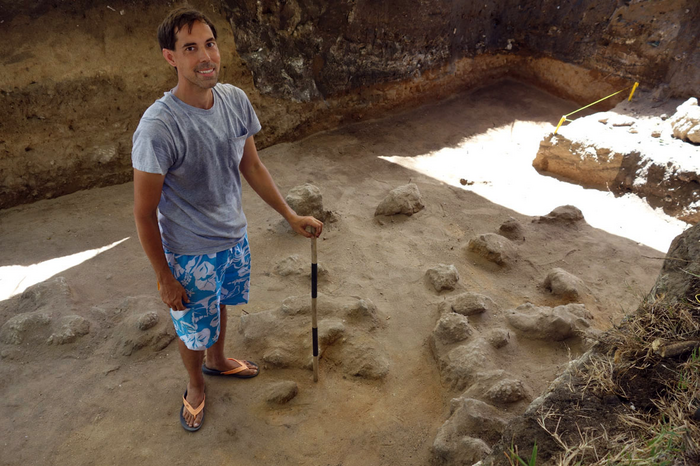An archaeological study has determined that cowrie-shell artifacts found throughout the Mariana Islands were lures used for hunting octopuses and that the devices, similar versions of which have been found on islands across the Pacific, are the oldest known artifacts of their kind in the world.

Credit: Micronesian Area Research Center, University of Guam
An archaeological study has determined that cowrie-shell artifacts found throughout the Mariana Islands were lures used for hunting octopuses and that the devices, similar versions of which have been found on islands across the Pacific, are the oldest known artifacts of their kind in the world.
The study used carbon dating of archaeological layers to confirm that lures found on the Northern Mariana Islands of Tinian and Saipan were from about 1500 B.C., or 3,500 years ago.
“That’s back to the time when people were first living in the Mariana Islands. So we think these could be the oldest octopus lures in the entire Pacific region and, in fact, the oldest in the world,” said Michael T. Carson, an archaeologist with the Micronesian Area Research Center at the University of Guam.
The study, titled “Let’s catch octopus for dinner: Ancient inventions of octopus lures in the Mariana Islands of the remote tropical Pacific,” is published in World Archaeology, a peer-reviewed academic journal. Carson, who holds a doctorate in anthropology, is the lead author of the study, assisted by Hsiao-chun Hung from The Australian National University in Canberra, Australia.
The fishing devices were made with cowrie shells, a type of sea snail and a favorite food of octopuses, that were connected by a fiber cord to a stone sinker and a hook.
They have been found in seven sites in the Mariana Islands. The oldest lures were excavated in 2011 from Sanhalom near the House of Taga in Tinian and in 2016 from Unai Bapot in Saipan. Other locations include Achugao in Saipan, Unai Chulu in Tinian, and Mochom at Mangilao Golf Course, Tarague Beach, and Ritidian Beach Cave in Guam.
Known artifacts, unknown purpose — until now
“The artifacts have been known — we knew about them. It just took a long time considering the possibilities, the different hypotheses, of what they could be,” Carson said. “The conventional idea — what we were told long ago from the Bishop Museum [in Honolulu] — was that these must be for scraping breadfruit or other plants, like maybe taro. [But] they don’t look like that.”
The shells didn’t have the serrated edge of other known food-scraping tools. With their holes and grooves where the fiber cord would have been attached as well as the stone sinker components, they appeared a closer match to octopus lures found in Tonga from about 3,000 years ago, or 1100 B.C.
“We’re confident they are the pieces of octopus lures, and we’re confident they date back to 1500 B.C.,” Carson said.
An invention of the ancient CHamorus?
Carson said the question now becomes: Did the ancient CHamoru people invent this adaptation to their environment during the time when they first lived in the islands?”
That’s a possibility, he said, the other being that they brought the tradition with them from their former homeland; however, no artifacts of this kind have yet been discovered in the potential homelands of the first Marianas settlers.
If the CHamoru people did invent the first octopus lures, it provides new insight into their ingenuity and ability to problem solve — having to create novel and specialized ways to live in a new environment and take advantage of an available food source.
“It tells us that […] this kind of food resource was important enough for them that they invented something very particular to trap these foods,” Carson said. “We can’t say that it contributed to a massive percentage of their diet — it probably did not — but it was important enough that it became what we would call a ‘tradition’ in archaeology.”
The next question to look at, Carson said, is whether there are similar objects anywhere else from an older time.
“Purely from an archaeology standpoint, knowing the oldest of something is always important — because then you can track how things change through time,” he said. “[…] The only other place that would be is in the overseas homeland area for the first CHamoru people moving to the Marianas. So we would look in islands in Southeast Asia and Taiwan for those findings.”
Journal
World Archaeology
DOI
10.1080/00438243.2021.1930134
Article Title
Let’s catch octopus for dinner: Ancient inventions of octopus lures in the Mariana Islands of the remote tropical pacific
Article Publication Date
2-Jul-2021




